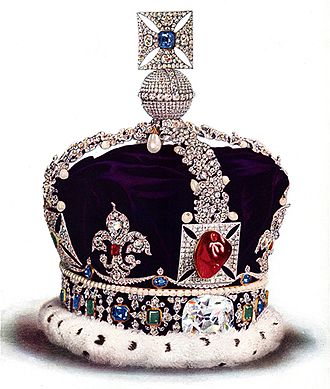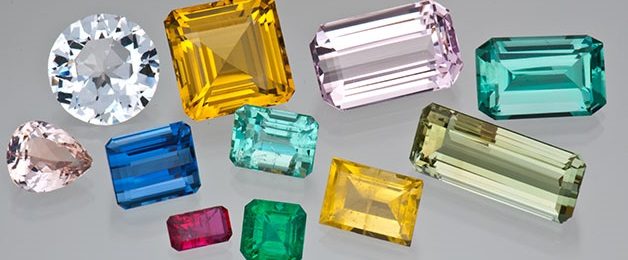The Black Prince’s Ruby is in fact not. It is a large spinel, which resulted in its infamous name “The Great Imposter”. This blood-drenched red stone has an intriguing and violent history. According to record, back in the 14th century, the stone was pillaged by Don Pedro the Cruel, the king of Castile & Leon, in Spain, from Adu Sai’d, the Prince of Granada , the stone’s original known owner. The “ruby” was next famously owned by the “Black Prince” – Edward of Woodstock, so known because of his success on the battlefield during the Hundred Year’s war. The next conqueror to own the stone was yet another successful warrior, King Henry V. The king had the stone set in his helmet and wore it when he defeated the French at the Battle of Agincourt. With some near losses, the gem remained in the hands of British Royalty, where it currently sits at the centre of the Imperial State Crown of England, above the Koh-i-Noor Diamond.

Imperial State Crown United Kingdom
The Black Prince’s Ruby is a large, irregular cabochon red spinel weighing 170 carats (34 g) set in the cross pattée above the Cullinan II at the front of the Imperial State Crown of England. The spinel is one of the oldest parts of the Crown Jewels. It has been in the possession of England’s rulers since it was given (if not reluctantly) in 1367 to its namesake, Edward of Woodstock (the “Black Prince”).
All red gemstones used to be referred to as “balas rubies” until 1783 when spinels were differentiated from rubies. The two gemstones can be distinguished on the basis of their chemical properties: a red spinel is a compound of magnesia, iron and chromium, while a ruby is a type of aluminium oxide. The rarity of this spinel, however, is that it is the biggest uncut spinel in the world. The unusual gem has only been polished slightly and has never received a proper cut. Today fine red spinel is actually considered to be rarer than ruby in occurrence and can often be even more valuable.
King Murders Prince
The Black Prince’s Ruby entered the stage of history in the middle of the 14th century as the possession of Abu Sai’d, the Moorish Prince of Granada. At that time, the rule of Castile was being centralized to Seville and the Moorish Kingdom of Granada was being systematically attacked and reverted to Castilian rule as a part of the Christian Reconquest of the Iberian peninsula. Abū Sai’d, in particular, was confronted by the belligerency of nascent Castile under the rule of Peter of Castile, AKA Don Pedro the Cruel. According to historical accounts, Abū Sai’d wished to surrender to Don Pedro. Don Pedro welcomed his coming to Seville. When Abū Sai’d met Don Pedro, the King had Abū Sai’d’s servants killed and may have personally stabbed Sai’d to death. When Sa’īd’s corpse was searched, the spinel was found and added to Don Pedro’s loot. It is said that the gruesome murder of the Prince sparked a curse that would follow Don Pedro from that day on. The curse was said to have brought misfortune or even death to those who owned the “Black Prince’s Ruby”.
Knight trumps King
Half brother to Peter the Cruel, Henry of Trastámara, led a revolt against Don Pedro. Lacking the power to put down the revolt unaided, Don Pedro made an alliance with the Black Prince. The revolt was successfully put down and the Black Prince demanded the ruby in exchange for the services he had rendered. While historians speculate that this was contrary to Don Pedro’s desires, he had just suffered a costly civil war and was in no position to decline. It can be assumed that the Black Prince took the Ruby back to England, although it is absent from historical records until 1415.
A wartime adornment
During his campaign in France, Henry V of England wore a gem-encrusted helmet that included the Black Prince’s Ruby. In the Battle of Agincourt on October 25, 1415, the French Duke of Alençon struck Henry on the head with a battleaxe, and Henry nearly lost the helmet, along with his life. The battle was won by Henry’s forces and the Black Prince’s Ruby was saved. Richard III is supposed to have worn the gemstone in his helmet at the Battle of Bosworth, where he died.
Crown Jewels
Henry VIII’s inventory of 1521 mentions “a great balas ruby” set in the Tudor Crown, thought to be the Black Prince’s Ruby. It remained there until the time of Oliver Cromwell in the 17th century. With the exception of the Coronation Chair and several other items, Cromwell had the principal symbols of the king’s power – the Crown Jewels – disassembled and sold, and the gold was melted down and made into coins. What happened to the Black Prince’s Ruby, during the Commonwealth of England is not clear, but it came back into the possession of Charles II when the monarchy was restored in 1660. At the coronation of Queen Victoria in 1838, she was crowned with a new Imperial State Crown made for her by Rundell and Bridge, with 3,093 gems, including the spinel at the front. This was remade in 1937 into the current, lighter, crown. A small plaque on the reverse of the gemstone commemorates the crown’s history.
Article References:
https://www.gia.edu/spinel-history-lore
https://en.wikipedia.org/wiki/Black_Prince%27s_Ruby
http://www.thepracticalgemologist.com/jewelry-history-1/2016/10/28/not-what-it-seems-the-black-prince-ruby?rq=black%20prince






